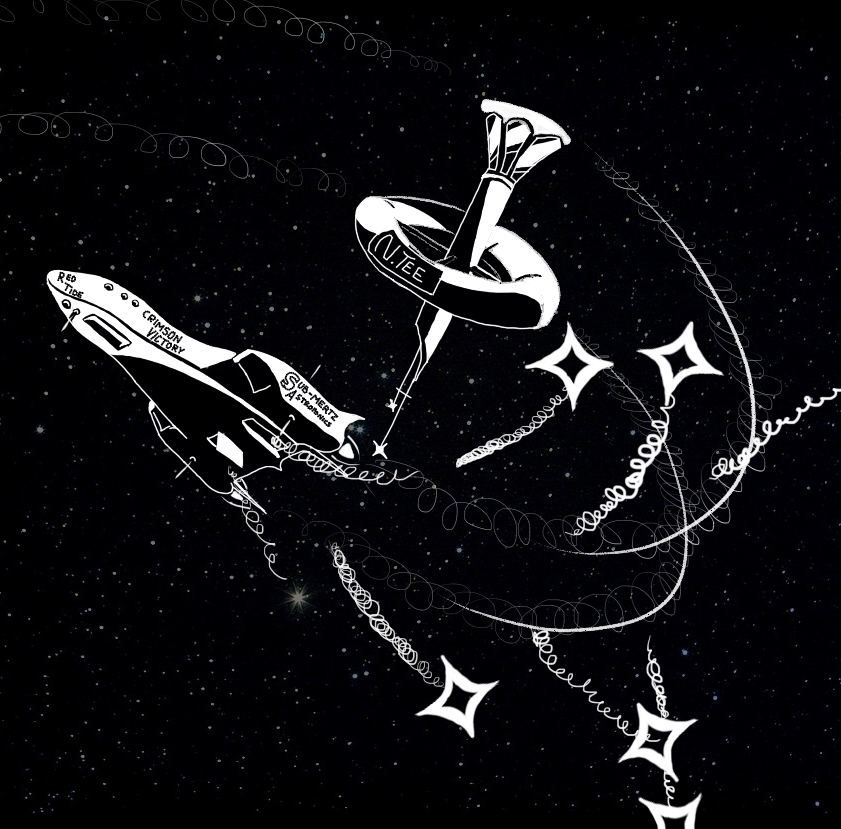Marathon Drone Races
Regulations
Vessels can be of any size, but must be completely unmanned, handled only by a computer program and scripting. It can contain no virtual or artificial intelligence but may have robotic chassis aboard if desired. Once launched, the vessel may only be contacted, communicated with or interacted with by the drone's team or race officials. Similarly, the drone may not interact with anything but the subjects of the race. Contact between drones is strictly forbidden. This refers to weapons, hacking or any other forms of obtrusion between drones. Unintentional contact, such as bumps and scrapes can be overruled by the race judges but still runs the risk of having points deducted from the team's final score. Any drone deemed responsible for the destruction, pacification or obstruction of another drone will be immediately disqualified. Every piece of the ship that started the race, must come back. Thus, a craft cannot have expendable stages or deployable craft that do not return. Exceptions to this rule are: * Expendable fuel * Fuel cells (not fuel tanks) * Reactor rods * Coolant cells * Ammunition * Pieces of the ship that have been damaged or destroyedQualifying
As with most races, a qualifying round is required to decide who starts first on the grid. A day is set aside for qualifying, usually a week before the event, where teams get to fly their drones around the aerial course as many times as they wish. At the end, the drones with the fastest times get to go first.Race Day
Stage One
It's a race first and formost and we decided the first events should show that. Everyone loves the classic starting grid and lap race, so we gave the people what they would've wanted.
The Aerial Course
The 20 lap aerial race is easily the most popular event of the season with packed seats all around. It is often also referred to as one of the loudest sports to ever exist, with the roaring of frigate engines interspersed with the pulsing whine of the fighters. Teams, during the race, are allowed to pit their vehicle and re-upload programs and scripts in the event that something needs to be changed. Often, the smaller, more agile fighter craft are required to pit in order to refuel, which is the balancing factor that leaves the slower, less agile frigates still eligible to win. As the contestants cross the line, their place is announced and the teams are granted points if they finished first through fifth (5 points for first place, 1 point for fifth). A signal is then sent from the control tower to the drone, which flags it to begin the next stage of the marathon.The Astrobatics Course
When they cross the finish line of the aerial course, the drones begin a high-powered ascent to orbit. This usually involves loud, bassy rockets that give the end of the race some brilliant fireworks. When in orbit, the drones are picked up on film by smaller camera drones that follow them around, giving vision to the people in the stands on the planet below. Others, who may prefer seeing the astrobatics personally can view from the small orbital stations that act as stands for the viewers and race organisers. The drones are required to pass through a gate when they reach the astrobatics course. This begins a timer that tracks how long it takes the racer to complete the course. The course is comprised of a number of hoops, pillar beacons and narrow gaps that would be a challenge even to an experienced pilot.On completion of the astrobatics course, the racers are then to head towards the edge of the system, where they will jump to the next stage.
Interception
On their approach to the edge of the system, the racing drones are flagged and pursued by fighter craft equipped with weaponry that can temporarily disable the racing drones' primary power functions. This effectively halts the drone for approximately a minute while the systems restart. These weapons can only fire once before they need to be rearmed. They do so at a nearby station which takes about ten minutes plus the time it takes them to travel to the station. Any drones hit by one of these disabling shots has a point deducted from their final score, making this event one of the most crucial parts of the marathon. The interceptor craft are always in contact with the home station, which delegates targets to the pilots to engage. Regulations state that only one interceptor can pursue a drone at any given time, when the pursuing craft fires its shot, it disengages and another can be sent to replace them. Any fighter not currently engaged is required to return to the station, and a fighter cannot be delegated to engage a drone that is currently disabled. This is by far the most tense part of the marathon and is many people's favourite. The action of starship combat in exhilarating and is interspersed with intelligent stealth tactics performed by some of the less combat-centric drones. Once the drones have passed a certain boundary, fighters are forbidden from firing at them. The drones are then to autonomously navigate and perform a Spike Drill to the next stage of the race. Because of the time that Spike Drills take, the end of the first stage can be anywhere from two to six days from the start of the second. Thus these areas of the broadcast are dedicated to sponsorship advertising, interviews with race officials and comments from the race teams.Stage Two
Spike Drills are difficult for navigators and even experienced ones can make mistakes. Failure was incredibly common in the early years of the races, with drones arriving in the system with massive swaths of the craft missing or damaged with some drones never arriving at all!
Search and Rescue
Hopefully in one piece, the racers immediately are sent a signal from a station in the system. This station beams data about one of the planets in the system as well as the data, pictures and last known location of a person who that drone is then timed to find, called the VIP. Most people view this as the deciding factor of the marathon, as bad luck and poor weather could mean their search takes days instead of the expected hour or two that has come to be standard. The event is arguably the most scrutinised event in the marathon for its reliance on luck and not very sporty practises. The coverage of this event is mostly done with some local camera drones that follow each contestant around the planet as well as each drone's on-board internal and external cameras.Transport and Delivery
When the individual has been found, the drone is to then pick them up and transport them as quickly as possible to an off-planet location given by the VIP. The drone is rated based on the time taken to get to the location, as well as the comfort experienced by the VIP. When finished, the drone has an opportunity to refuel at a station near the edge of the system if it is required. Then the drone punches in the numbers and navigates to the next system.Stage Three
When the races were being put together, it was decided that tests of speed shouldn't be everything. Some sort of ability for arithmetic prowess should be able to be displayed in the event as it is so essential to the construction of these advanced vehicles. This decision caused the third stage to be introduced.
Orbital Mechanics Trials
Immediately as the drones are arrive, a local station pings them with the coordinates of every planet and body in the solar system. It signals which ones are important then gives them a set of instructions:The drone will be scored for the distance to the star, which is a great challenge as most of the drones suffer heating issues from housing many petabytes of processing power aboard which is already a hassle to keep cool.
Similarly, this is judged based on proximity to the body.
This event is different to the other in this system, as it is scored depending on how the manoeuvre was as a whole. Thus, if the flyby near the sun was average, the second encounter was poorly done and the third was great, their score for the third step will be average.
The twist that makes this event one of the greatest challenges of modern technology instead of just a tricky interplanetary obstacle course comes in the form of an override signal sent from the nearby station that deactivates the drone's engines a mere ten minutes after they enter the system. Most computers with enough time could execute this manoeuvre perfectly, but with the time constraint as well as the time needed to perform the manoeuvre's burn make this timer a massive factor in the performance of the vessels involved. Often, some racers will completely miss the orbital injection they desire and lose all points for the round! In an attempt to stop losing drones to intense heat, solar radiation and sudden impact with planet-sized objects, a rule was set in place where the drones could send an emergency signal to the nearby station, which would reactivate the drone's engines allowing it to escape the predicament that made it signal. Invoking this rule forfiets any and all points gained in the third stage of the marathon. At the end of the marathon, teams are given extra points depending on how quickly the manoeuvre was performed (5 points for first, 4 for second etc.).
Final Stage
Most racers coming home to the final stage of the marathon do so alone, as the many delays that could impede racers along the way are likely to spread the contestant drones out quite a lot. But in the rare case where two drones arrive in-system at approximately the same time then the crowds waiting for the drones' return grow wild and competitive, waiting to see who will be the first to cross the line.Planetfall
There are only two ways of getting score in this step of the race. One is by being one of the fastest drones to get from the system boundary to planetside, and the other is being the first through fifth drone of the race to cross the line. Planetfall is a spectacle to behold as most of these drones are able to take forces that would kill normal men. The high speed descents creates meteor-like flames in the sky as their communications are momentarily cut off by the superheated plasma. As they come home, each drone does a final lap around the aerial course they began with before the position of the drone and their final points score is announced. To close off the drone's activity in the marathon, each team usually has a parade (or at least, a crowd of photographers) around the drone as it is transported from the pit box to the drone's long range transport vehicle.Points to be Scored
Stage One
1-5
+1 per manoeuvre
-Times Hit
Stage Two
1-10
Stage Three
1-5
1-5
Totals
Total Points:
40
Popular Teams
Crimson Victory
A true underdog in their first race, Red Tide was considered only in competition of Lightning IX, the fighter hull racing drone of Listen Gate. Eyes widened, however when Red Tide won the Aerial Course by an astonishing 18 minutes. Setting a new record in the process. This time advantage slipped as Red Tide struggled to find it's VIP in stage two, and Kovie's 'Liberty' overtook them. The race ended with both drones re-entering the home planet's atmosphere simultaneously to a roaring crowd. As the drones rocketed into range of the aerial course and banked hard to take the first corner, Red Tide's aerodynamic capabilities partially failed. One of the rear winglets, damaged from the forces of re-entry, shattered. Leaving the drone crippled in the last leg of the race, allowing Liberty the victory.
Calamain
People often view Calamain as unsportsmanly. Since they are subsidized by the biggest and most advanced technological provider in the sector, they naturally have access to technology that is completely unfathomable to the other teams. Among the spectators, there are some who dont even view Horizon as even competing to begin with, and generally start their leaderboards at 2nd place.
Listen Gate
Listen Gate are venerable among contestant teams in the marathon drone races and have been fighting from the start to earn medals. Their drone; 'Lightning' has been reconstructed so many times, that they stopped enumerating it after the drone's name in 2989. They were the first team to win the aerial and astrobatics course, but also the first drone to fail a spike jump, resulting in most of the aft section of the craft being destroyed. Thus eliminating them from the race.
Since, they've been clawing for the top spot, trying to win with speed and dexterity instead of shelling out millions of credits for the best technology possible. They, and most of their fans are advocates of the older 'bodging it' style of engineering, which is likely the reason for their drones' faults.
Kovie
While they may be embarrassed to admit it now, the team has become a moral story as to how sports can transcend ill feelings and stop major political disputes.













I love the sheer amount of detail put into this. The vignette is a well-used summary, and every header thereafter answers a different question I might have about your article. I'm actually sorely tempted to try to answer similar questions within my own article! I especially liked the fact that in the teams you added a bar which showed their team color, but it took me a few reads to realize that was the point. Wonderful use of a timeline!
I see your point about the banners, but there isn't a much better option to show the team colours without using a lot of space from what I can see. I'm happy that you enjoyed it though and I always like making people ask questions about their own work!